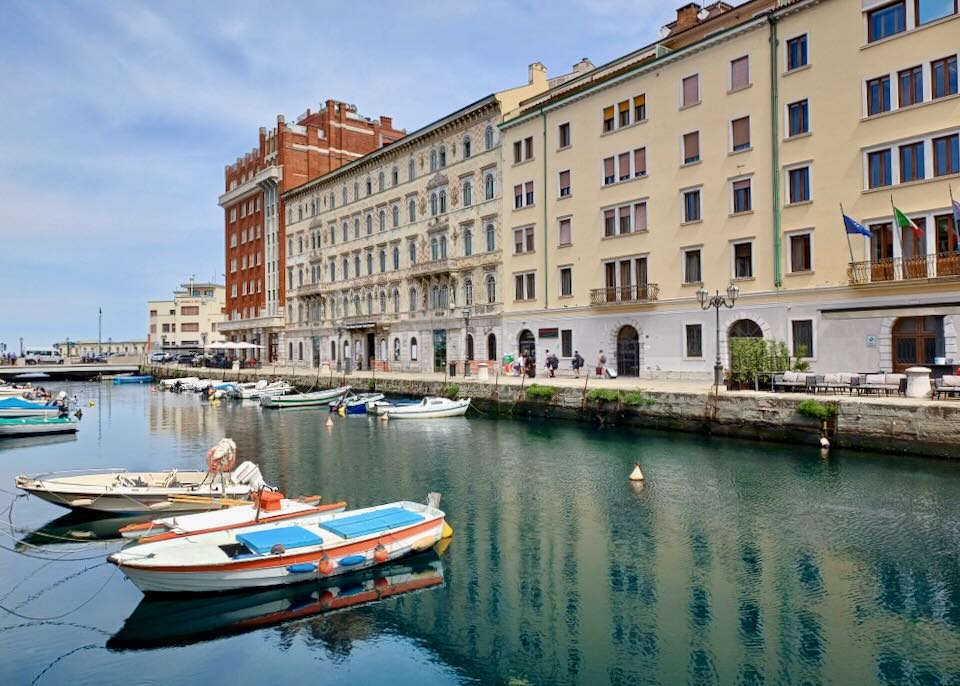
We walked along the Canal Grande towards the water.
The Best Areas to Stay in Trieste
Nestled within its namesake bay, at the very precipice of the expansive Adriatic Coast, Trieste emerges as a significant Italian city and a pivotal port. Often overshadowed by the magnetic tourist draw of iconic destinations like Milan, Florence, and Rome, or even the singular allure of nearby Venice, Trieste nevertheless maintains a consistent appeal for discerning travelers. It presents a comprehensive array of attractions that cater to the typical desires of visitors to this region: a protracted history eloquently narrated by its imposing architecture and insightful museums; an extended esplanade boasting a marina and ferry terminals offering connections to other captivating locales; vast public squares bustling with al fresco dining options; and an Old Town replete with charming boutique hotels. Beyond these core features, Trieste offers distinctive highlights including ancient Roman ruins, a striking cathedral and a medieval castle dramatically perched atop a hill overlooking the city, the enchanting Miramare Castle just a short distance up the coast, and a picturesque miniature canal that serves as a subtle nod to its renowned Venetian rival.
Adding to its considerable draw, nearly all of these significant sights and the majority of tourist amenities are concentrated within a flat, remarkably compact area. This pedestrian-friendly zone is characterized by traffic-free laneways, teeming with lively bars, diverse restaurants, and unique boutiques. The city’s appeal is further amplified by the seamless ease of travel both to and within Trieste, facilitated by highly convenient bus and train stations. These hubs offer robust connections not only across the city and throughout Italy, but also to neighboring Slovenia and Croatia, positioning Trieste as an accessible gateway to the wider region.
Trieste Neighborhoods
The obvious center for locals and focal point for tourists is wonderfully compact. This area stretches from the bus/train stations to the ferry terminals only a 20-minute walk away, and the backstreets expand just a few blocks to the south and east until the hilly suburbs.
We have designated the City Center as the area at and around Piazza Unità d’Italia, one of Europe’s largest squares. Facing the sea and linked to other squares and the Canal Grande by pedestrian-only laneways, this area is an undisputed hub of tourist amenities and attractions that some visitors rarely go anywhere else.
East of the City Center, and within just a few minutes’ walk, the streets are less crowded. This area is home to several major attractions, notably the imposing San Giusto Cathedral and Castle, and the steep and winding streets of the Old Town that surround both.
The traffic-free streets and squares flanked by cafés and neo-classical buildings continue to Borgo Giuseppino, south of the City Center. This distinctive area along the harbor and esplanade is home to ferry terminals, an aquarium, cruise-ship docks, and a marina.
Borgo Teresiano, north of the City Center, is convenient to all the main attractions and amenities, especially the train and bus stations. Canal Grande dominates this area, which is nothing like Venice, but still a lovely spot to do what everyone else does: sip coffee and watch people.
Some stay around the bus and train stations, even though this transport hub is within a 10-minute walk of the City Center. Hotels there offer more affordable rates and convenience to inner-city buses, long-distance buses, trains, and shuttlebuses to the airport.
For something different, and just a few bus stops from the City Center, is Barcola, a delightful seaside suburb popular among locals and unaffected by tourism. It’s a worthy base with shaded parks, cycle paths, and waterfront cafés, even if the beach is disappointing.
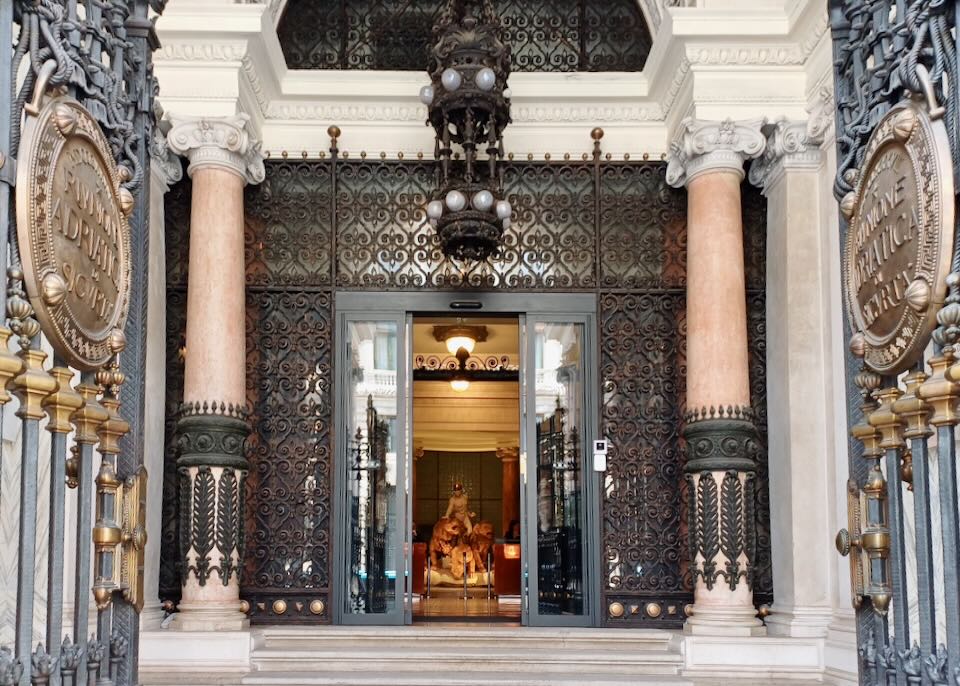
The gorgeous entrance to the DoubleTree, our favorite hotel for families.
The Best Places to Stay in Trieste
- Best Luxury Hotels in Trieste
Savoia Excelsior Palace • DoubleTree • Hotel Continentale • Grand Hotel Duchi d’Aosta • Forvm Luxury Experience • Hotel Vis à Vis- Best Boutique Hotels in Trieste
Hotel Solun • Seven Historical Suites • Forvm Boutique • The Modernist • Palazzo Talenti 1907 • Hotel Coppe- Best New Hotels in Trieste
The Modernist Hotel • DoubleTree • Hotel Solun- Best Cheap/Midrange Hotels in Trieste
Hotel Colombia • Five Flowers • Hotel Italia • B&B Hotel Trieste • Tre Merli Beach • Hotel Greif Maria Theresia- Best Hotels for Families in Trieste
DoubleTree • Residence La Torre • Albergo alla Posta • Residence Le Terrazze • B&B Hotel Trieste • Tre Merli Beach- Best Hotels for Couples in Trieste
Forvm Boutique • Savoia Excelsior Palace • Hotel Solun • Palazzo Talenti 1907 • Hotel Città di Parenzo • The ModernistBest Areas in Trieste for…
- Best Area in Trieste for First-Time Visitors: Borgo Teresiano (North of the City Center)
The crowds and noise around the City Center can be overwhelming, even for experienced travelers. If visiting Italy or Trieste for the first time, consider staying in the compact area between the two major attractions: Piazza Unità d’Italia (the main square) and the Canal Grande (a short inlet from the sea lined with cafés).We walked to the Piazza Unità d’Italia.
This area is relatively quiet, and hotel rates are less expensive, but it’s within a few minutes’ walk of the train station (where local buses stop) and the long-distance bus terminal (with services to the airport). And if the crowds and prices get too much, head to Viale Venti Settembre, a shaded and traffic-free laneway packed with shops and outdoor cafés behind the Canal Grande.
- Best Area in Trieste for Sightseeing: City Center
For a comparatively small city, Trieste packs a punch – and, thankfully, all sights are within walking distance, accessible using the excellent public transport, or easy to reach on a sightseeing tour. And the prime place to stay is the City Center, especially around the enormous Piazza Unità d’Italia square. From this area, it’s very easy to walk to: (1) the esplanade to arrange boat trips, and board ferries to Muggia, a charming town heavily influenced by its Venetian origins; (2) the bus and train stations for services across the region, including daytrips to Koper in Slovenia; (3) the meandering and steep Old Town with its Roman ruins; and (4) the funicular station for the hilltop San Giusto Cathedral and Castle.We stopped at the tourist Information office at Piazza Unità d’Italia where we got our Trieste City Map.
Around Piazza Unità d’Italia, agencies offer sightseeing tours to the majestic Miramare Castle and Muggia; and the helpful tourist office provides the useful (and free) Trieste City Map listing 70+ museums, galleries, statues, churches, piazzas, and historic cafés.
- Best Area in Trieste for History: City Center
The city’s strategic position and significance as a major port have ensured that Trieste has a long, colorful, and, at times, brutal history. Evidence of the Venetian, Roman, Austro-Hungarian, and Slovenian rule and influences is obvious throughout the compact inner-city area.We saw the ruins of Teatro Romano, an amphitheater.
From the enormous Piazza Unità d’Italia square, the focal point of much of the city’s history, it’s just a few minutes’ walk to the Teatro Romano, ruins of a Roman amphitheater dating back over 1800 years. (It can be admired for free from the street, but is closed to the public.) Roman ruins, like the Arco di Riccardo from the 1st century BC, pepper the streets of the Old Town between the Teatro Romano and the remarkable San Giusto Cathedral and Castle on the hilltop. The Trieste City Map (see above) lists over 20 museums showcasing the city’s incredible history.
- Best Area in Trieste for Vibe: Barcola
Let’s face it, locals living in apartments and tourists enjoying the sights crowd the inner-city area from the bus/train stations to the ferry terminals. To truly appreciate the real Trieste, head to, or better, stay at the delightful seaside suburb of Barcola. This is where city residents head to soak up the sun and swim in the sea (so it can get reasonably busy on sunny weekends). Yes, the beach is barely a patch of pebbles, but the suburban and seaside vibes are quite infectious with shaded parks, cycle paths, ocean views, and waterfront cafés.- Best Area in Trieste for Nightlife: City Center
There is not a lot of nightlife in Trieste, but there are some nightclubs and bars with live music in the City Center, especially in and around Piazza Borsa, which is almost connected to Piazza Unità d’Italia. Contact the tourist office (see earlier) in the main square for information about festivals, concerts, and other special events held during the warmer months.- Best Areas in Trieste for Shopping: City Center and Borgo Teresiano (North of the City Center)
Although not nearly as fashionable as Milan or Florence, there are certainly enough inviting places around the City Center to do some severe credit card damage. Upscale boutiques line Piazza Borsa (within a two-minute walk of the main square) and Spiridione street, which links both squares with the Canal Grande. These shops tend to avoid the clichéd and kitsch souvenirs and focus on jewelry, cosmetics, and fashion clothing (including outlets of stores from Milan and tailors).We enjoyed the upscale boutique shops around Piazza Borsa.
We enjoyed the shops and cafés along Viale Venti Settembre street in Borgo Teresian.
Far less crowded, and with shops (and cafés) priced for locals, not tourists, is Viale Venti Settembre, a shaded, traffic-free laneway that starts just behind the Canal Grande. And some may prefer the outdoor markets along the streets between the Canal Grande and Piazza Unità d’Italia, and around Piazza Venezia, south of the City Center.
Our trip through the Street market around Canal Grande.
- Best Area in Trieste for Swimming: Barcola
There is little to get excited about if you want to swim, sunbathe, or try some water sports. The only sliver of coastline with any possibility of swimming is in the suburb of Barcola, only 10 minutes by bus #6 from Piazza Oberdan (via the train station). Families cram the tiny pebbly beach on sunny weekends, but most locals go to Barcola to lie on a towel or lounge chair to soak up the sun and jump into the sea when it gets too hot.- Best Area in Trieste for Boat Trips: Borgo Giuseppino (South of the City Center)
Around Trieste, there are no islands to visit, caves to explore, or dolphins to spot like the coasts and islands of Croatia and Slovenia. You may find one or two kiosks along the southern esplanade offering a sunset cruise or a trip along the coast to the majestic Miramare Castle.We enjoyed the views at the Borgo Giuseppino Marina.
Otherwise, jump on a 30-minute ferry to Muggia, a charismatic town with a real Venetian vibe. Better yet, organize a boat trip for fishing, cave diving, snorkeling, or island-hopping at Piran (Slovenia) or just about anywhere along the Istrian Coast of Croatia.
- Best Area in Trieste for Restaurants: Borgo Teresiano (North of the City Center)
Not surprisingly, most cafés and bars in and around the main square, Piazza Unità d’Italia, and the Canal Grande are crowded and noisy. However, prices along the Canal Grande – a quiet, scenic but short canal – are not as lofty as perhaps imagined because of the intense competition. Most eateries at these places choose to specialize in what most tourists seem to want – pizza – or owners make a point of displaying a sign ‘No Pizza!’. But we prefer the string of cafés along the quiet, shaded, and traffic-free laneway, Viale Venti Settembre, which starts just behind the busy Canal Grande but is entirely unaffected by mass tourism. Most patrons are locals or Italian visitors, so prices are pretty reasonable, and finding a table is easy. The Trieste City Map (see earlier) includes a collection of Historical Cafés worth visiting for the ambience.- Best Area in Trieste Without a Car: Around the Bus & Train Stations
While Trieste offers more centralized parking than most cities of this size, there is no need to bring a car. The inner-city bus service is frequent, comfortable, and cheap, and there are regular ferries to Muggia (see earlier) and places further north along the coast (in summer).We rode the local bus in front of the train station.
But the reality is that most places to stay, eat, drink, shop, and see are within walking distance of each other. In fact, the inner-city area from the bus/train stations to the ferry terminals is only a 20-minute stroll.
- Best Area in Trieste for Transport: Around the Bus & Train Stations
Trieste must receive praise for its very convenient transport hub: the train station and bus terminal (with services to the airport) are side-by-side and less than a 20-minute walk from every hotel listed, except those in Barcola, 10 minutes away by bus. Buses around Trieste are regular and cheap, but rarely needed, except for Barcola, the San Giusto Cathedral and Castle, and the Old Town surrounding the cathedral/castle. (Route #24 through the Old Town is a minibus because the streets are too narrow for a regular bus.) The main terminals to catch local buses are outside the train station and at Piazza Oberdan. The indispensable Trieste City Map mentioned earlier lists the bus numbers for most places of interest. There are also ferries to Muggia and spots along the coast north of the City Center in summer. (See later about renting e-bikes.)- Best Area in Trieste for Families: Barcola
Trieste may not be the best place to bring the kids. The historical sights, ambience, views, and cafés may not be as appealing to youngsters as the boat trips, theme parks, and beaches available further down the coast in Slovenia (e.g., Portorož) and Croatia (e.g., Novigrad and Umag). In Trieste, there are no resorts with amenities for children.The playground in the park in Barcola is great for kids.
Perhaps, base yourself in more appealing places like Koper (in Slovenia), an easy day trip by bus to/from Trieste; or stay at the enjoyable seaside suburb of Barcola. Barcola has a likeable vibe, shaded parks, playgrounds, cycle paths, and hotels with family rooms. And it’s just a few stops on bus #6 from Piazza Oberdan (via the train station).
- Best Area in Trieste for Couples: East of the City Center
While certainly not as romantic as Venice, Rome, or Milan, Trieste does offer an extended marina to stroll along, historical buildings and ancient ruins to visit, an Old Town to explore, endless coffee shops to linger in, and upscale boutiques for a splurge. Adding further to the appeal are cycling paths around Barcola, a lovely seaside suburb; sightseeing tours of castles and cathedrals; and the ferry to the fascinating town of Muggia, with its obvious Venetian-style vibe. And there is no shortage of gorgeous boutique hotels to cap off a memorable visit, especially east of the City Center.- Best Area in Trieste on a Budget: Around the Bus & Train Stations
Almost everywhere to stay in and around the City Center is expensive – even more so during the peak season (June, July, and August). In contrast, most hotels are moderately priced around the convenient bus and train stations, both within a 10-minute walk of the City Center. These hotels cater to budget-minded travelers, and some offer a rarity: ‘single rooms’ with a single bed at reduced rates, ideal for solo travelers. Some places with unlikely names like Hotel Colombia, Hotel Bristol, and Hotel Roma are along noisy roads, so choose wisely. And the shops, cafés, and bars around this area are used by, and priced for, locals, not tourists.
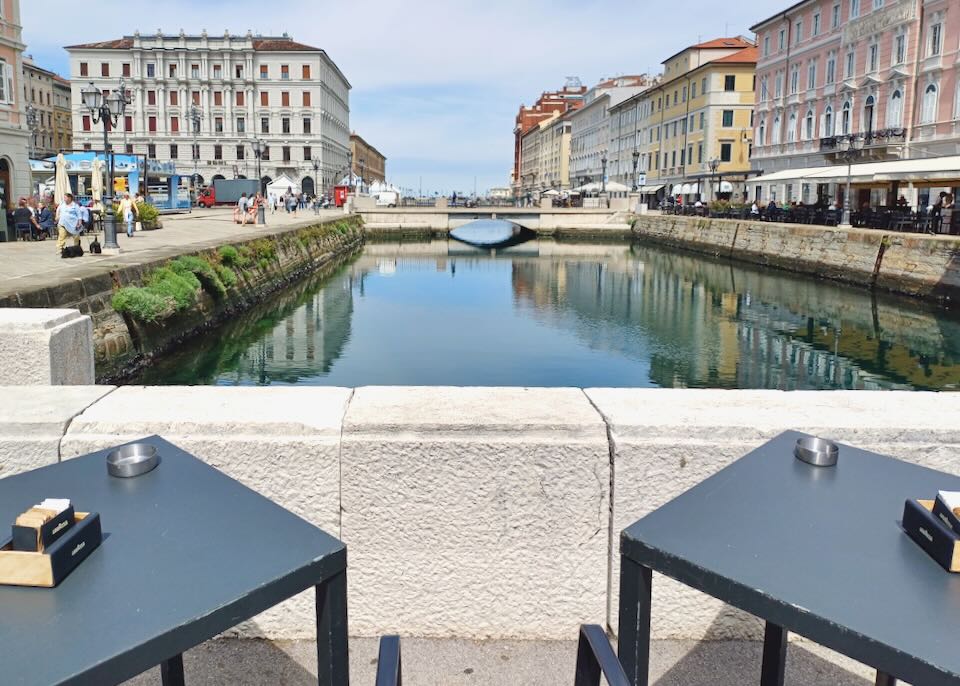
We sat at a café, enjoying the Canal Grande, people-watching, and the sea view in the distance.
The Best Areas in Trieste for Tourists Ordered from the City Center Out.
City Center
The Fountain of Neptune is in Piazza Borsa, in front of the gorgeous pink Chamber of Commerce building. To the left and closer to the building is the Statue of Gabriele d’Annunzio (a poet) sitting on a bench reading.
Some visitors rarely seem to venture further from the City Center, which stretches from the Canal Grande (a short inlet from the sea) to Piazza Unità d’Italia, the largest sea-facing square in Europe. This area of pedestrian-only laneways and other, smaller squares offers so much for tourists, such as agencies selling sightseeing tours, cute boutiques and department stores, especially around Piazza Borsa nearby, and classy cafes perfect for sipping coffee and watching people (particularly along the Canal Grande).
Adding further to the appeal are the markets around the Canal Grande and behind Piazza Unità d’Italia (on weekends), the modicum of nightlife in the backstreets, and simply strolling along the broad esplanade. All hotels are compact and most are upmarket, with little in the moderate range or suitable for families.
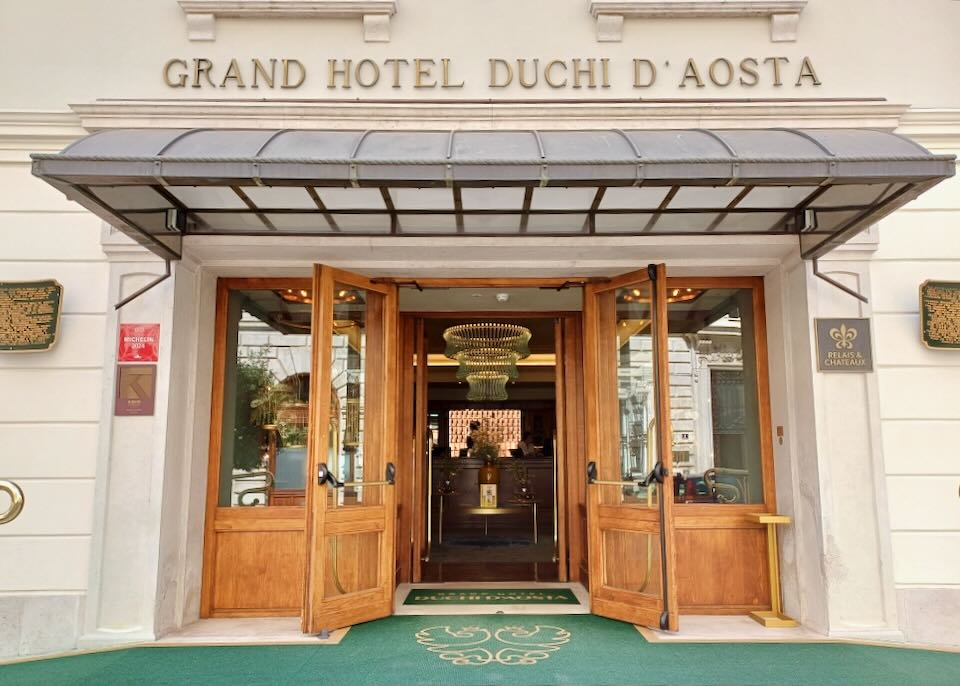
Grand Hotel Duchi d’Aosta is our favorite 4-star hotel in Trieste.
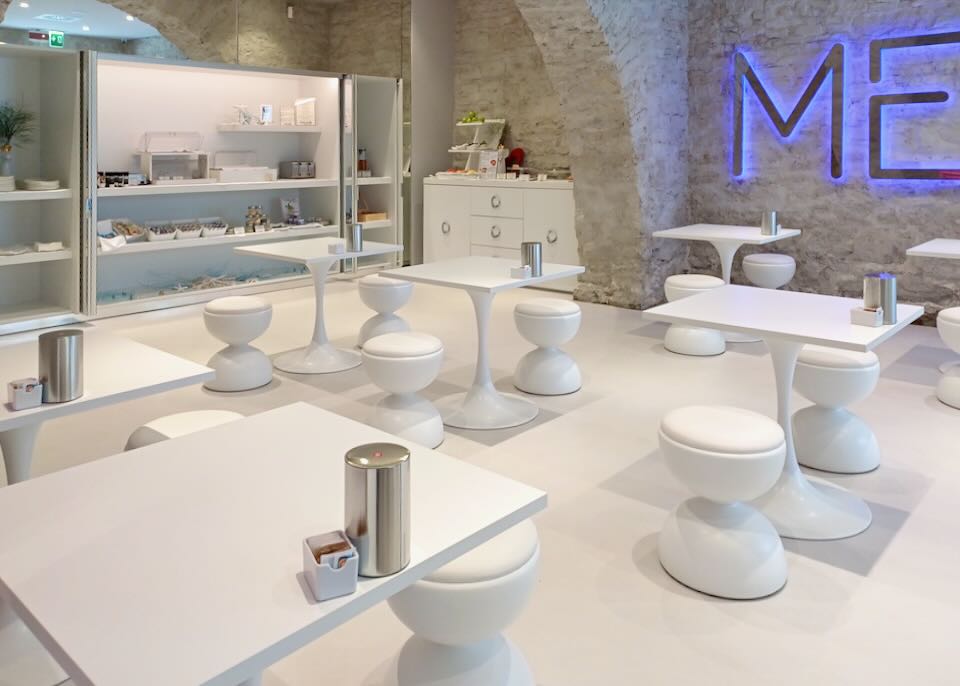
The café and buffet in the modern You.Me Design Place Hotel.
- Best Luxury Hotels in the City Center
Grand Hotel Duchi d’Aosta • Hotel Vis à Vis • Hotel Coppe- Best Boutique Hotels
Hotel Coppe • You.Me- Best Moderate Hotels
Locanda al Volo Tor Bandena • Locanda al Volo Tommaseo- Best Privately-run Rooms & Apartments
The Gallery • S1 • Piazza Grande City Residence • Locanda alla BeccherieEast of the City Center
We toured the 15th-century San Giusto Castle and fort, which is also a museum.
The area immediately east of the ring road (Spiridione, which turns into Teatro Romano) and including the Old Town is quieter and more spacious than the City Center. It offers three major attractions: (1) the Teatro Romano ruins of a Roman amphitheater, explored from the outside only, (2) the magnificent San Giusto Cathedral and Castle perched side-by-side on top of a steep hill, and, (3) the meandering Old Town between the Teatro Romano and cathedral/castle.
Streets and lanes in the Old Town are steep, but a funicular leaves from a car park next to the Teatro Romano, or the minibus #24 from outside the train station (via Piazza Oberdan). Some top-quality luxury and boutique hotels are ideal for couples and convenient to the City Center, waterfront, and bus/train stations, but nothing worth recommending in the moderate range (except privately-run rooms and apartments) and little to excite families.
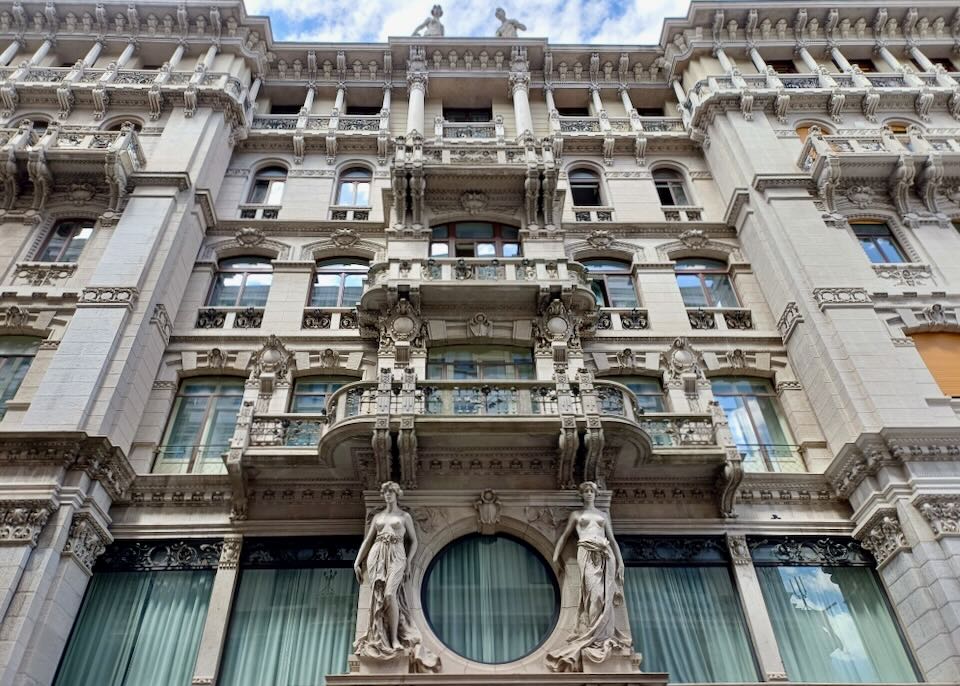
The Art Nouveau façade on the Palace Suite.
- Best Luxury Hotels East of the City Center
DoubleTree • Hotel Continentale • Palace Suite- Best Privately-run Rooms & Apartments
Residence Teatro Romano • Le Finestre • Residence Montanelli- Best Boutique Hotels
Albero Nascosto • The Modernist • Hotel Città di Parenzo • Hotel All’Arco- Best Hotel for Families
DoubleTreeBorgo Giuseppino
Even the Pharmacy is charming in Borgo Giuseppino (Pharmacy At Redeemer).
Between the esplanade and hilly suburbs, and south of the main square, Piazza Unità d’Italia, are even more places to stay, eat, drink, and shop. Quietly distant from the tourist crowds, this area offers shaded parks, smaller squares, outdoor markets, and cafés packed with locals. There is a genuine harbor-side vibe all over, with the Aquario Marino aquarium (temporarily closed), terminal for cruise ships, wharves for ferries to Muggia (see earlier), and marina for possible boat trips around the bay.
The choice of accommodations is limited chiefly to privately-run rooms and apartments, so nothing much for families, but the ambience is so likeable. Places listed below are still within a 20-minute walk (or a few bus stops) of the bus and train stations.
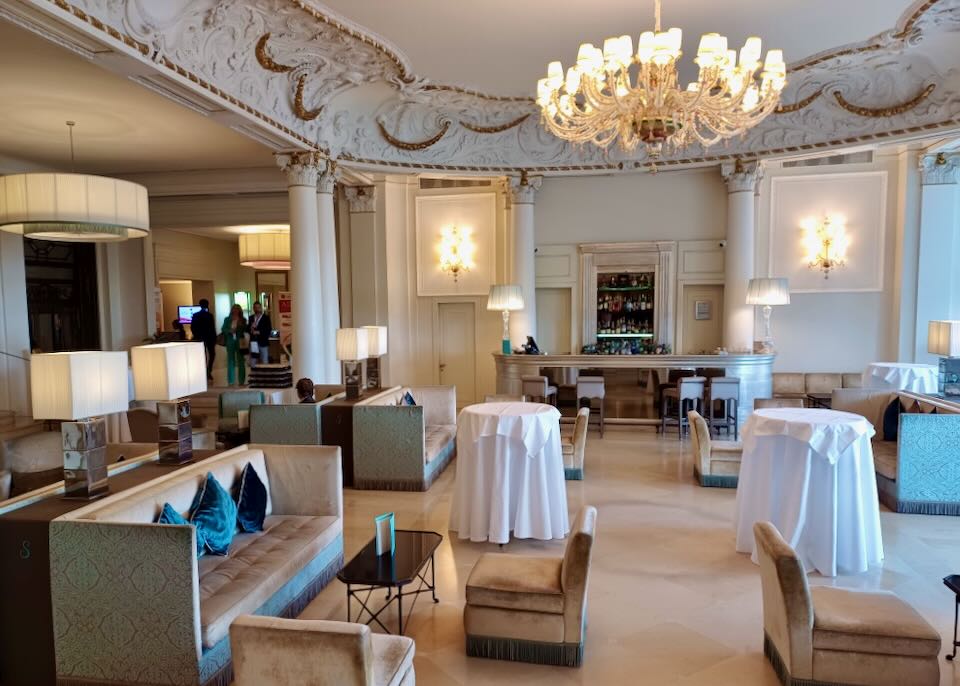
The lobby of the Savoia Excelsior Palace, our favorite 5-star hotel and best hotel with a view.
- Best Luxury Hotel in Borgo Giuseppino
Savoia Excelsior Palace- Best Privately-run Rooms & Apartments
B&B Adelaide • Elisabeth • Residence Liberty • Residence Al Granzo- Best Boutique Hotels
Urban Hotel Design • James Joyce- Best Moderate Hotel
Five FlowersBorgo Teresiano
Canal Grande and the Church of Sant’Antonio Nuovo at the end.
This area is north of the City Center and squeezed between the bus/train stations (mentioned below) and the Canal Grande, which signals the start of the main, pedestrian-friendly section of the City Center (see above). Sometimes called “New Town,” Borgo Teresiano is convenient and ideal for first-time visitors. There are three main hubs: (1) Canal Grande, which peters out after about 200 meters/yards and is not remotely comparable to anything in Venice, but lined with classy cafés, (2) Piazza Oberdan, surrounded by charming boutique hotels, affordable eateries, and bus stops for services across the city, and (3) Viale Venti Settembre, a shaded, traffic-free laneway packed with outdoor cafés far quieter and cheaper than the tourist hotspots.
Across Borgo Teresiano, there are several top-end hotels – mostly compact, stylish, and expensive – but nothing much for families or in the moderate range. Plenty of privately-run accommodation, as usual.
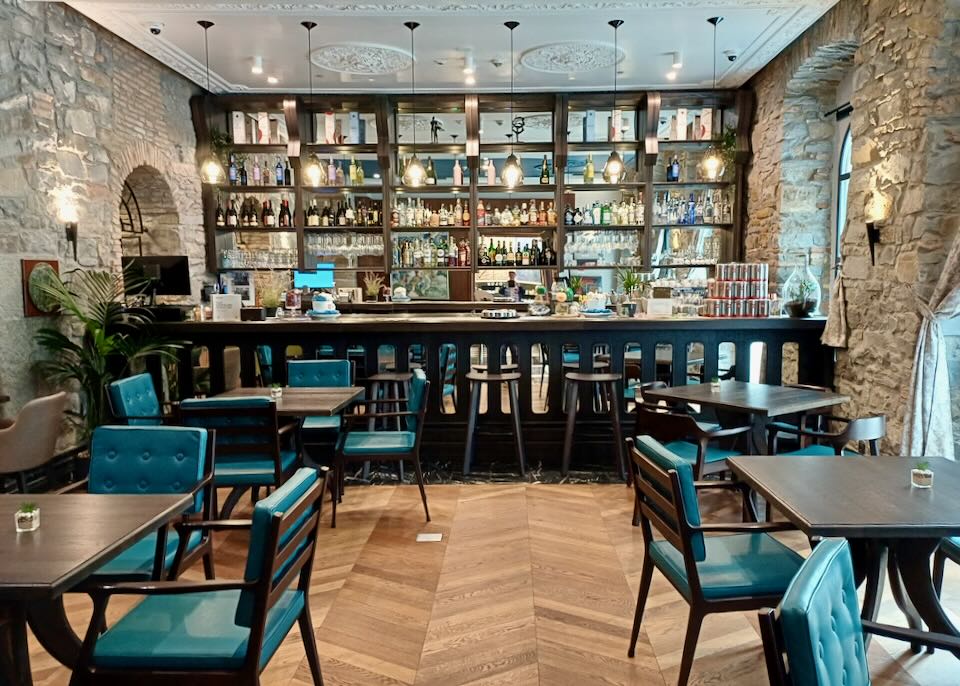
The bar in our favorite boutique hotel, Hotel Solun.
- Best Luxury Hotels in Borgo Teresiano
Forvm Luxury Experience • Seven Historical Suites • Hotel Solun • Albergo alla Posta- Best Privately-run Rooms & Apartments
Antico Borgo Teresiano • Mimì Rooms&Studios • Residence Sole • Smart Rooms • Bed and Breakfast al Cucherle- Best Boutique Hotels
Seven Historical Suites • Forvm Boutique Hotel • Palazzo Talenti 1907 • Albergo Al Viale • Le Cupole- Best Moderate Hotels
Hotello • Nuovo Albergo Centro • Residence Le Terrazze- Best Hotels for Families
Albergo alla Posta • Residence Le Terrazze • Hotel SolunAround the Bus and Train Stations
This is an example of a typical piazza (square) in the area.
As explained earlier, Trieste has a great inner-city transport system and a convenient hub for long-distance buses and trains just a 10-minute walk from the City Center at Piazza Unità d’Italia square. Offering great value are the numerous 2-star hotels along the streets (some of which are noisy) and handy to the efficient train terminal, bus station, and stops for buses across the city and to the airport.
The train station.
Very little in the luxury or boutique range, and nothing much recommended explicitly for families, but some moderately-priced accommodations offer “single rooms” at reduced rates ideal for solo travelers. There are not a lot of choices for eateries, but staying here is all about convenience and value. Note: places north of the train station will be further from the City Center and may be too close to the railway lines for a decent night’s sleep.
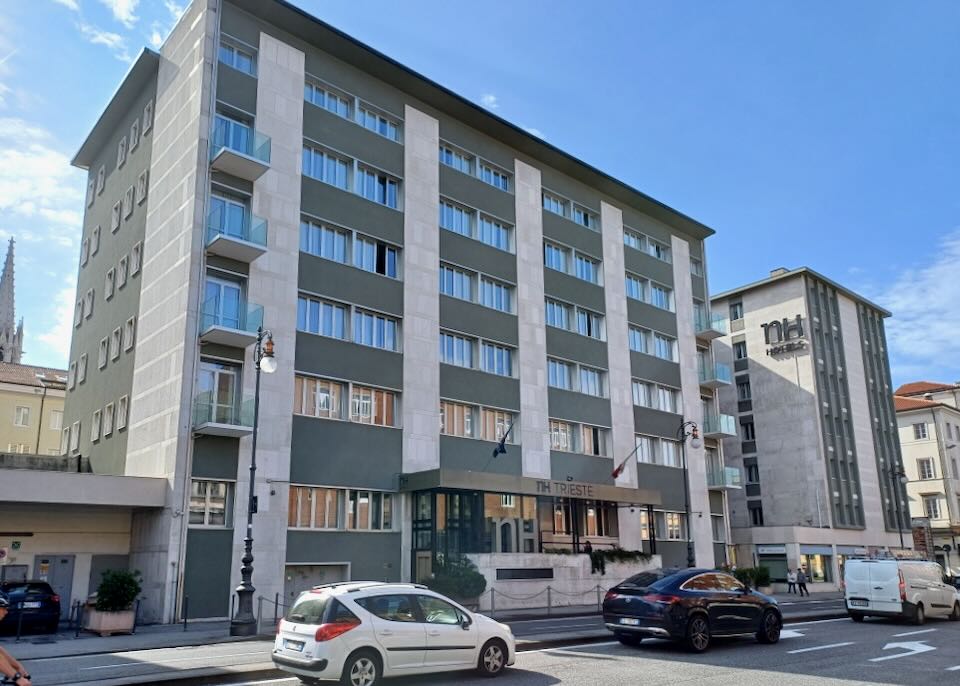
The NH Trieste Hotel is just a few blocks from the ferry terminal.
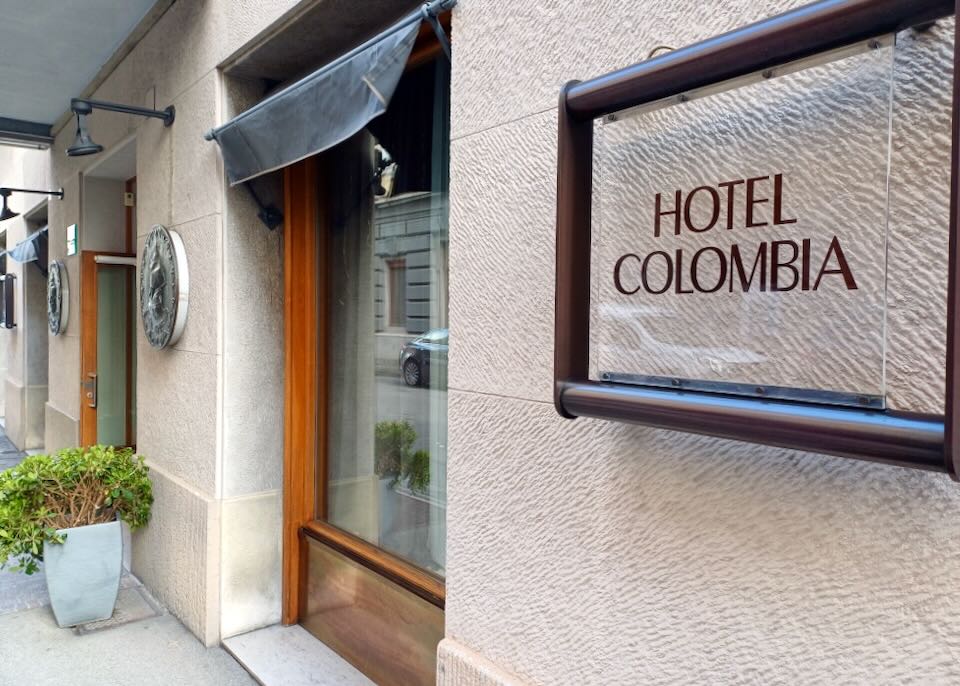
Hotel Colombia is our favorite cheap hotel.
- Best Luxury Hotel Around the Bus and Train Stations
NH Trieste- Best Privately-run Rooms & Apartments
Perfect Stay Apartments • Dada • Cosy Moods • Affittacamere Iris- Best Boutique Hotels
Hotel Colombia • Pensione Rittmeyer- Best Moderate Hotels
Hotel Colombia • Hotel Italia • B&B Hotel Trieste • Hotel Milano • Hotel Roma • B&B Trieste Plus • Hotel Bristol- Best Hotels for Families
B&B Hotel Trieste • Le SalineBarcola
We enjoyed the shaded park by the sea.
The enjoyable seaside suburb of Barcola seems so distant from the crowded piazzas and tour buses around the City Center. Still, it is only a few stops on bus #6 from Piazza Oberdan (via the train station). As the only place in and around Trieste for swimming and sunbathing, the vibe is infectious as locals flock to the waterfront cafés and shaded parks with playgrounds and picnic tables. Everyone lies on a towel or lounge chair on the concrete to soak up the sun and jumps into the sea from a ladder or platform. There is a tiny patch of pebbles that could be called a “beach,” but it gets impossibly crowded on sunny weekends. Adding to the attraction are the cycle paths from the City Center (with e-bikes to rent at both places) and views across the bay.
There is a small pebble beach and sidewalk for sunbathing in Barcola.
Although it’s the best place for families and anyone who wants to escape the tourist crowds and enjoy a slice of genuine Italian lifestyle, accommodations are limited. But there are three interesting options: motel-style rooms facing the sea (Tre Merli), a hotel with spa and wellness facilities (Greif Maria Theresia), and rooms with up to three bedrooms ideal for families (La Torre). Otherwise, there’s a range of privately-run and good-value accommodation in the hilly backstreets.
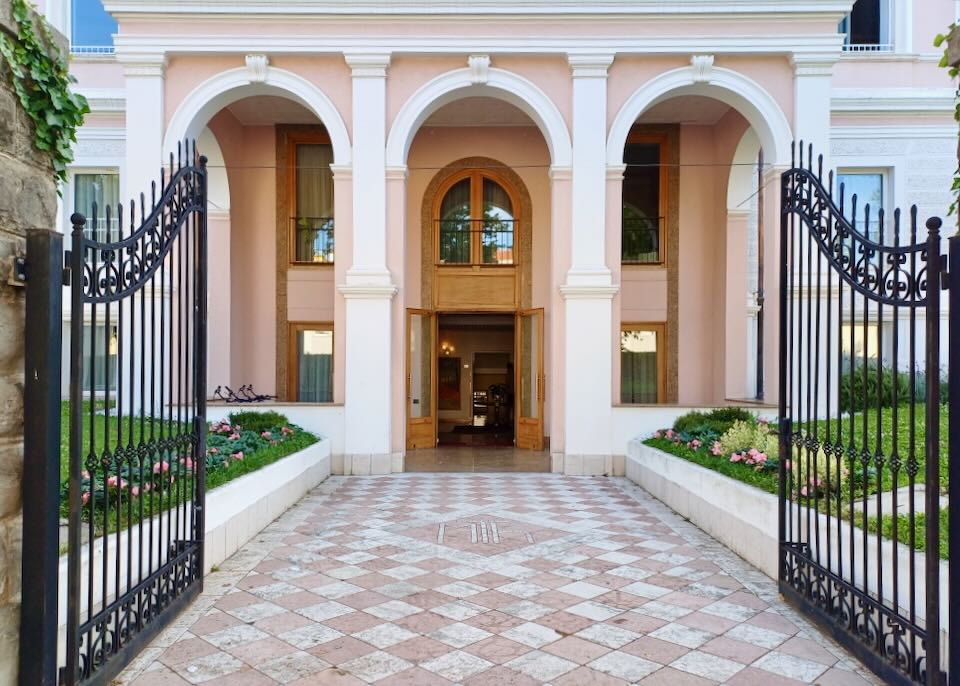
Our favorite Hotel at the Sea is Hotel Greif Maria Theresia.
- Best Privately-run Rooms & Apartments
Casa Vacanze Barcola • Casa Vacanze NATASCIA • Trieste Sea Life • Villa Bonafata b&b- Best Moderate Hotels
Tre Merli • Hotel Greif Maria Theresia • Hotel Tritone- Best Hotels for Families
Residence La Torre • Tre MerliTop Travel Tips for Trieste
- From Piazza Oberdan and the stop outside the train station, bus #6 goes to Barcola, and minibus #24 is handy for the San Giusto Cathedral/Castle and steep sections of the Old Town nearby. Buy tickets at a tobacco kiosk, on most street corners. The all-day ticket is good value and convenient.
- Probably 80% of accommodations in and around Trieste are privately run rooms and apartments. Most are in 4 to 6-level buildings around the inner-city area that look remarkably similar. Some places are also poorly signposted – or not at all – so get detailed instructions about the address and access from the owner.
- Trieste can get overcrowded during the peak season (June, July, and August). With one or two cruise ships in dock, the crowds can be even worse, so perhaps explore the sights before 10am and after 6pm.
- E-bikes are available at all tourist hotspots, but these are really only useful at Barcola and south of the City Center. It’s best to explore the inner-city area on foot, and streets east of the City Center are far too hilly for bikes.
Our Favorite Hotels in Trieste
5-Star Hotel: Savoia Excelsior Palace
Superb position facing the sea and so close to the main square, this imposing hotel oozes so much elegance, history, and charm.4-Star Hotel: Grand Hotel Duchi d’Aosta
Grand by name and design, this is on the edge of the main square and very stylish, luxurious, and convenient.Boutique Hotel: Hotel Solun
So instantly likeable, with shuttered windows facing a quiet street, tasteful décor throughout, and brightly-colored rooms with stone walls.New Hotel: The Modernist
Chic and new but within an old-style building, the Modernist is striking, from the designs of the street-side windows to the dazzling décor throughout.Cheap Hotel: Hotel Colombia
Nicest of many 2-stars offering convenience to the City Center and bus/train stations, the design is funky, rooms spacious, and service attentive.For Family: DoubleTree
Faultless location on a surprisingly quiet street offers all the amenities expected of an international 5-star, plus genuine grace, history, and style.For Couples: Forvm Boutique
Handy position, stunning design with stone walls, fascinating art, and soft colors. Service is immaculate with ultra-luxurious apartments nearby.Best at the Sea: Hotel Greif Maria Theresia
Splendid design, yet so understated, and in the likeable seaside suburb of Barcola, it offers a spa, gym, bike rental, and other ‘wellness’ facilities.Views: Savoia Excelsior Palace
Magnificently positioned along the esplanade, most rooms have full or, at least, partial views of the marina, sea, and crowds along the main streets.
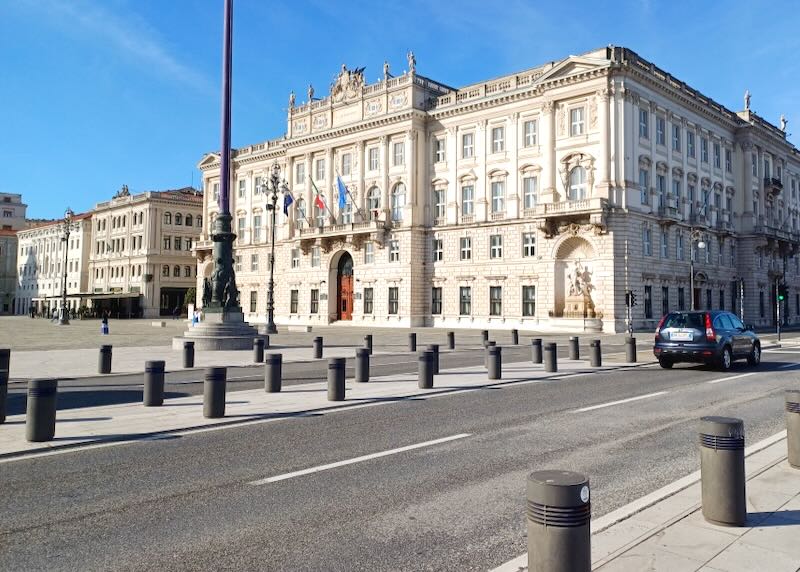
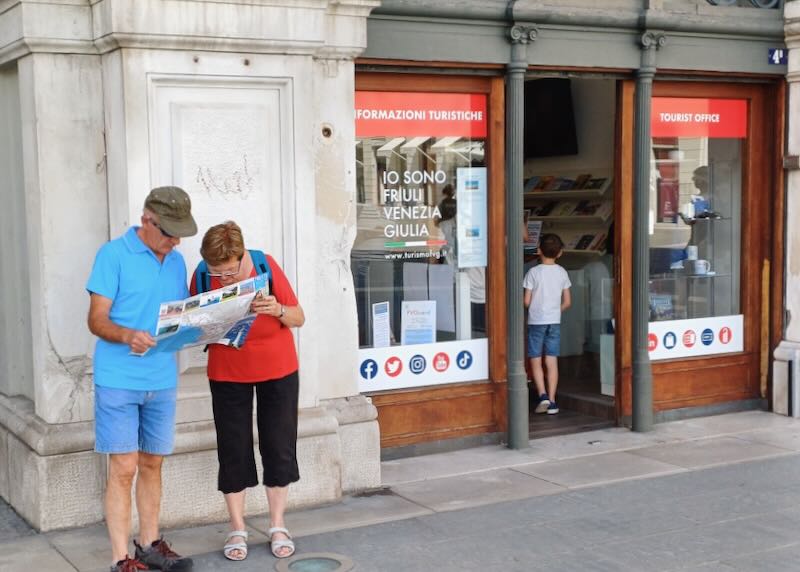
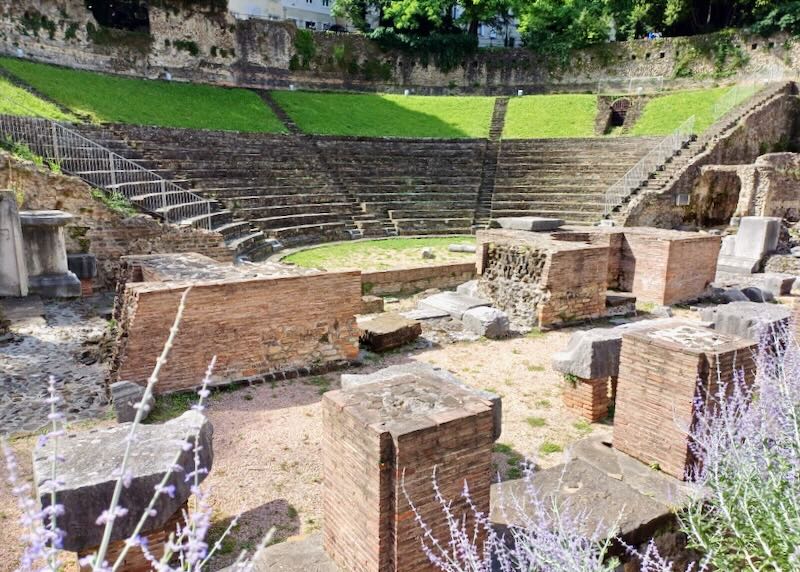


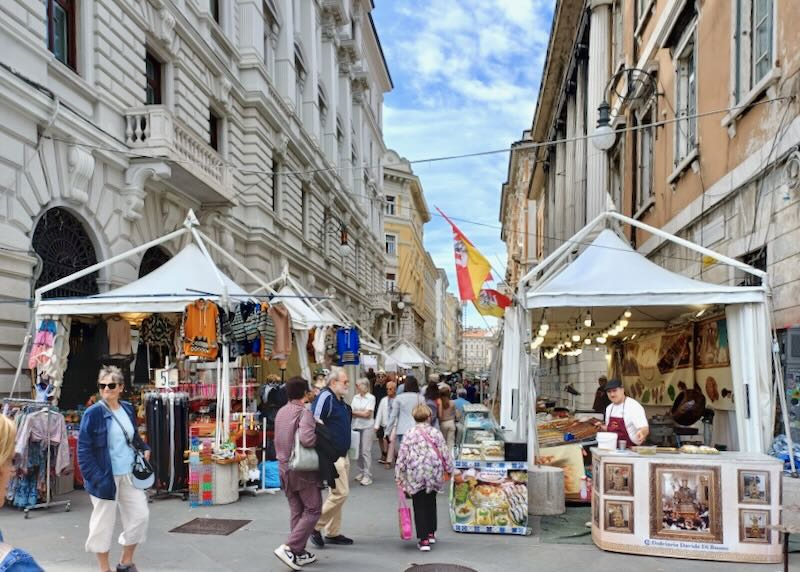
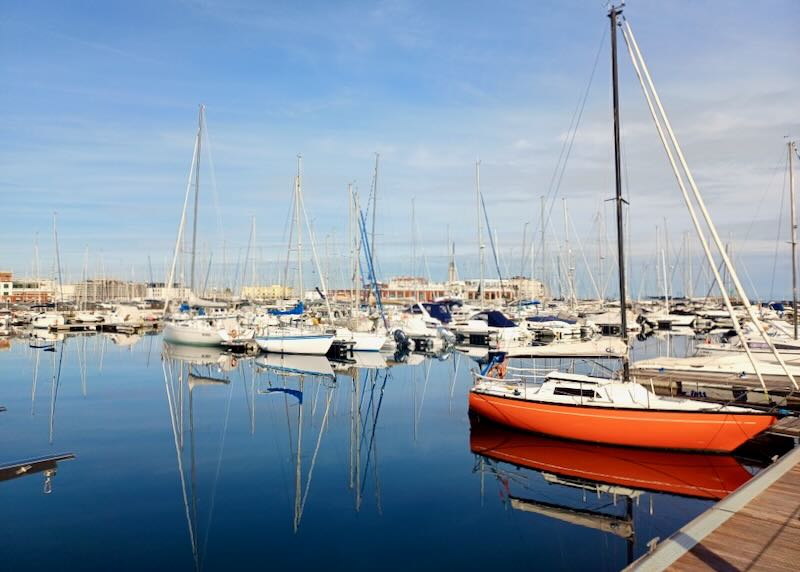
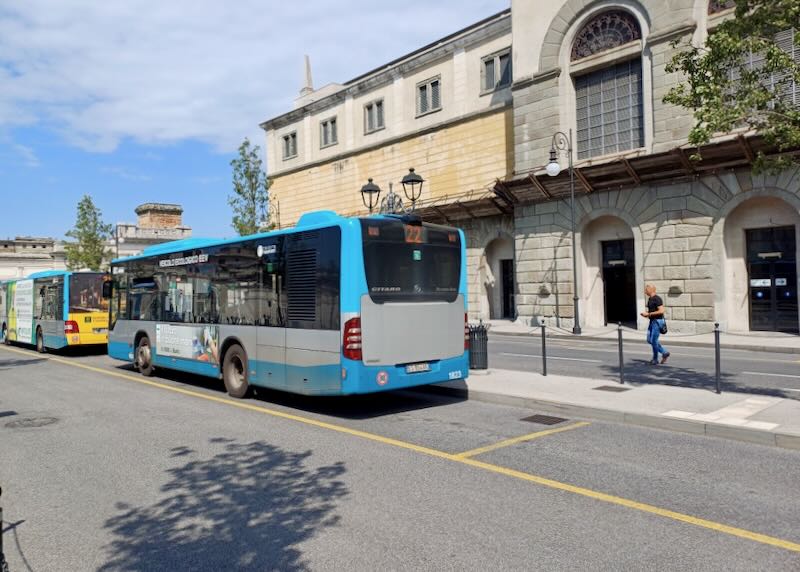
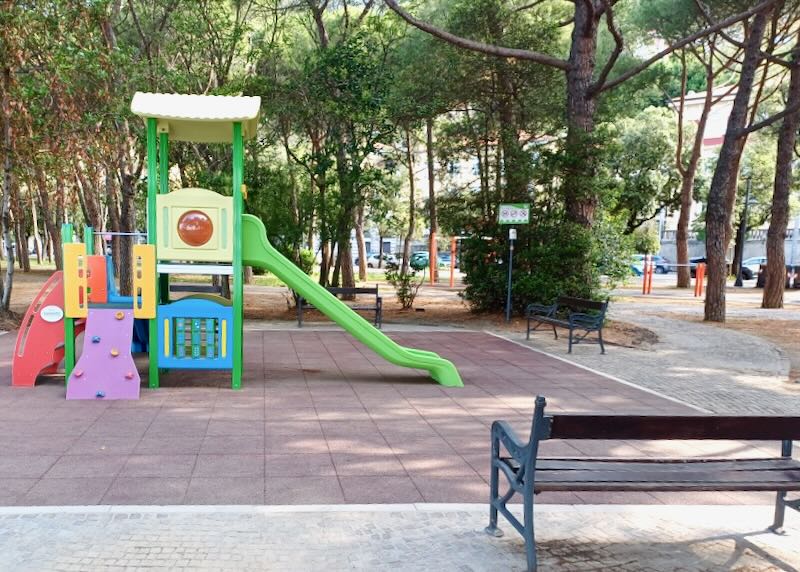
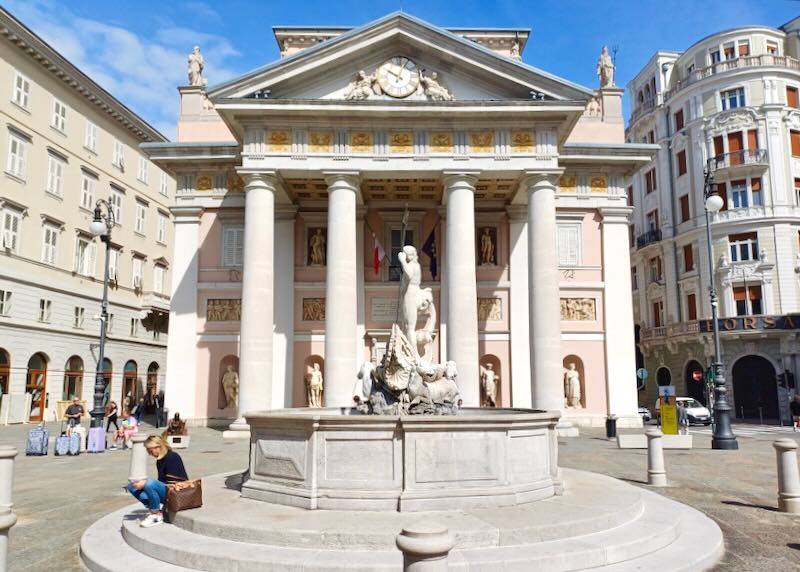
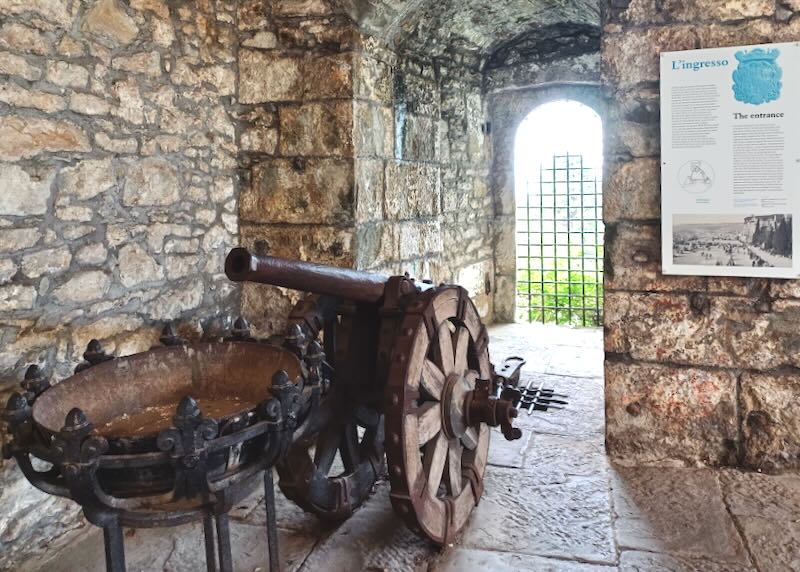
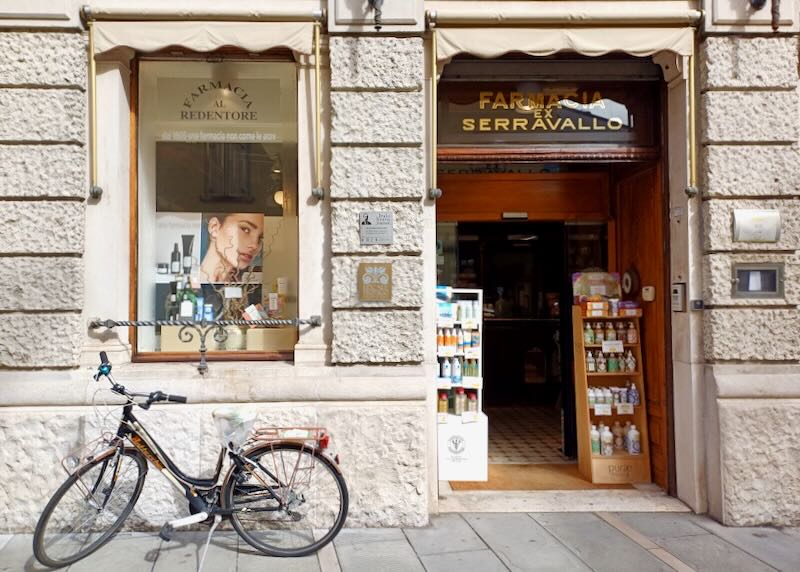
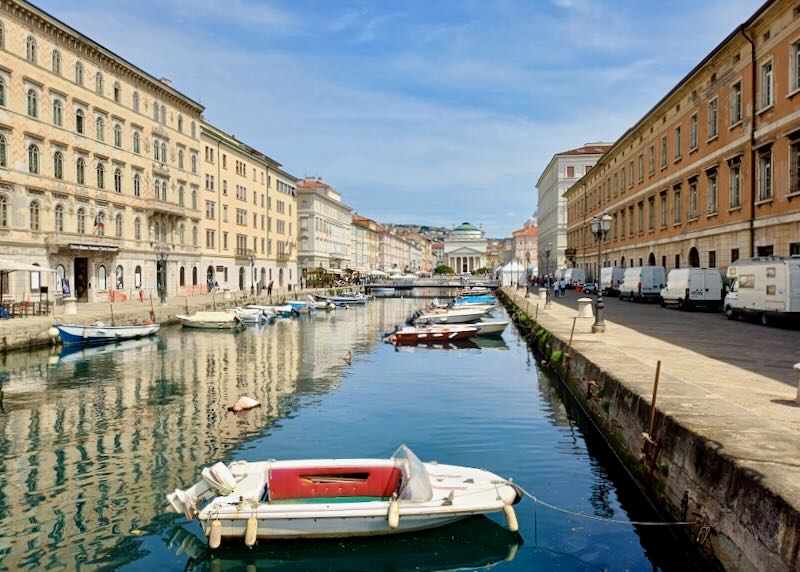
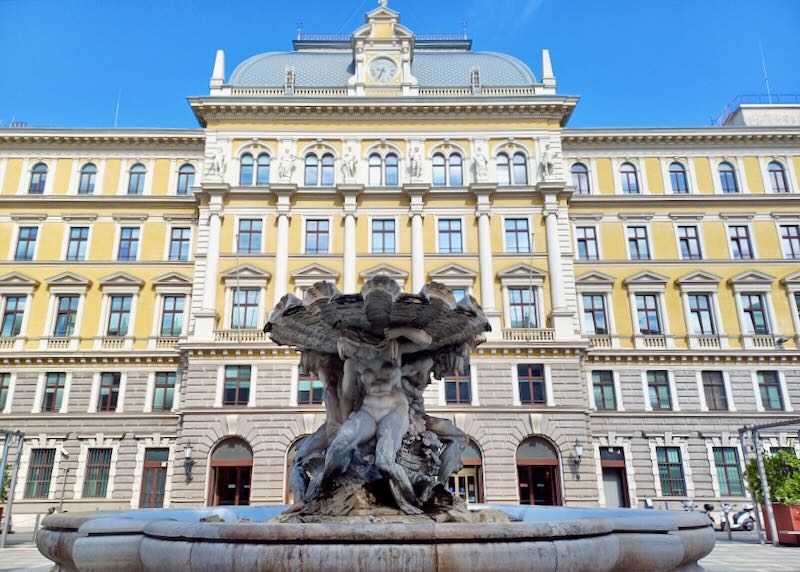
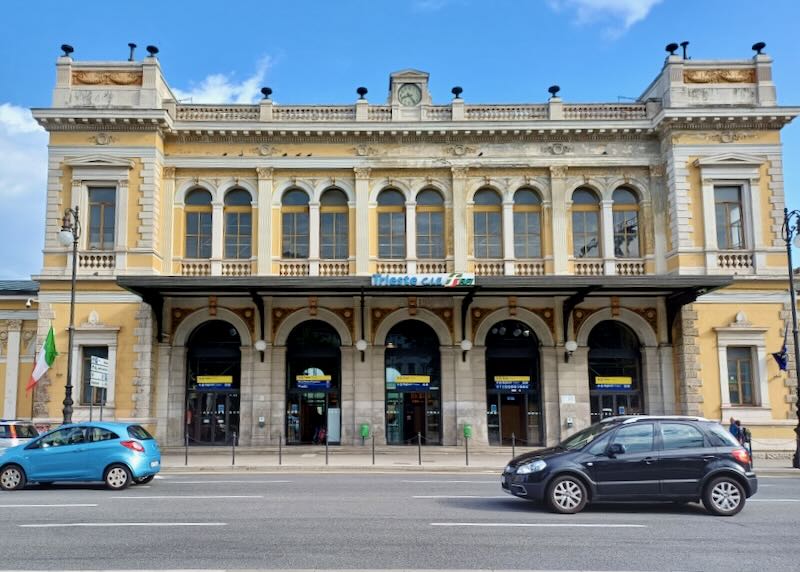
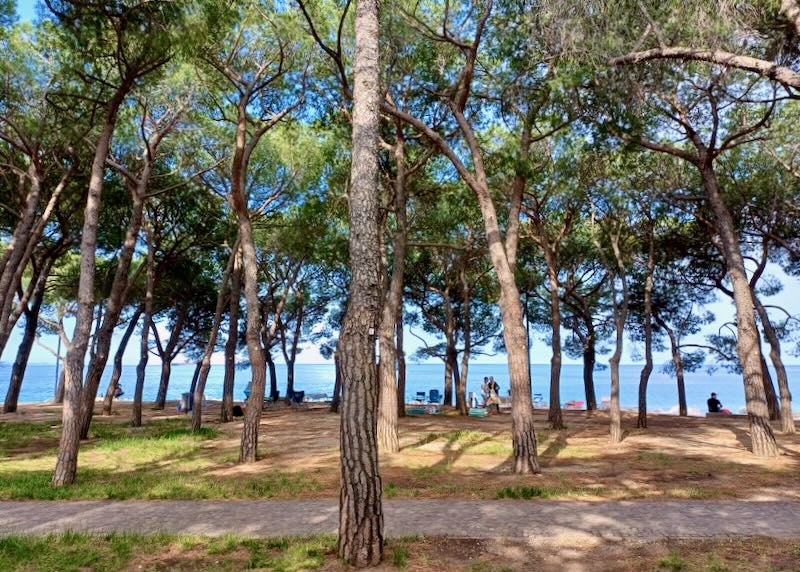
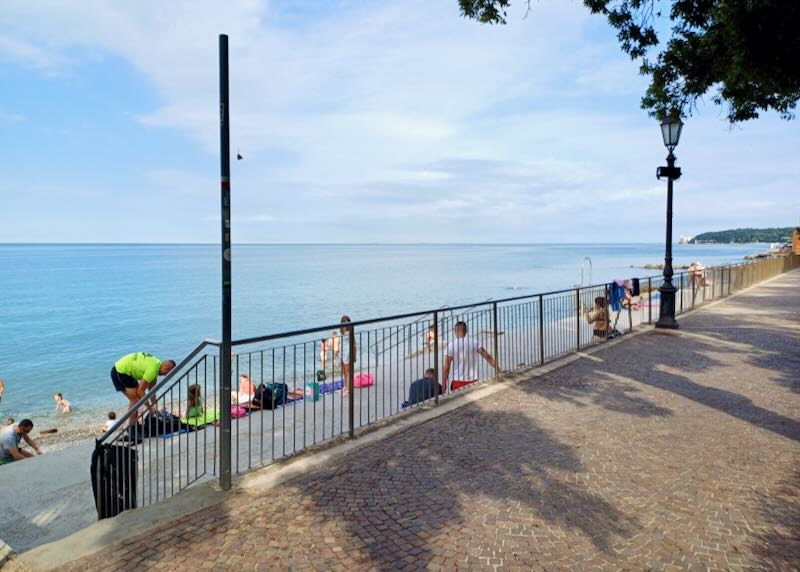
About Santorini Dave